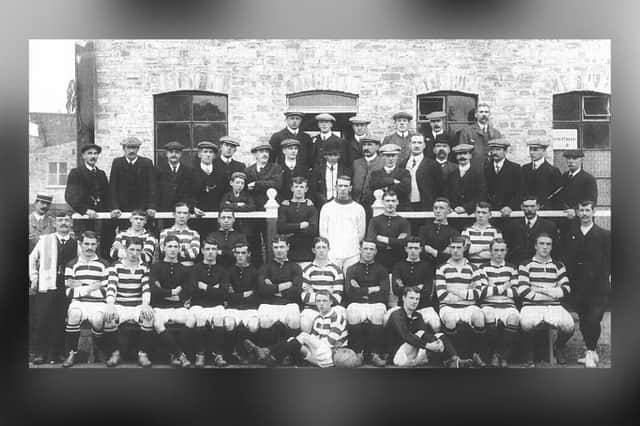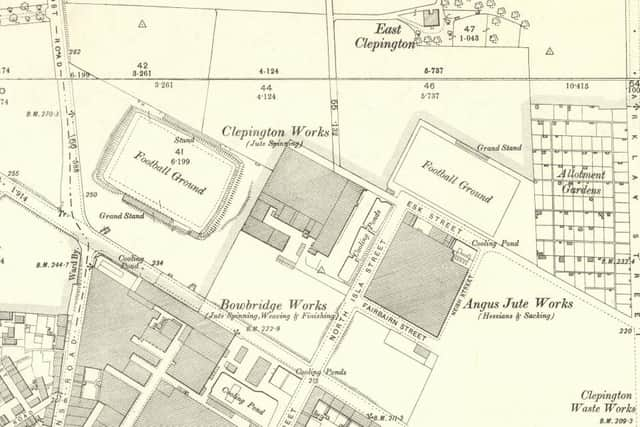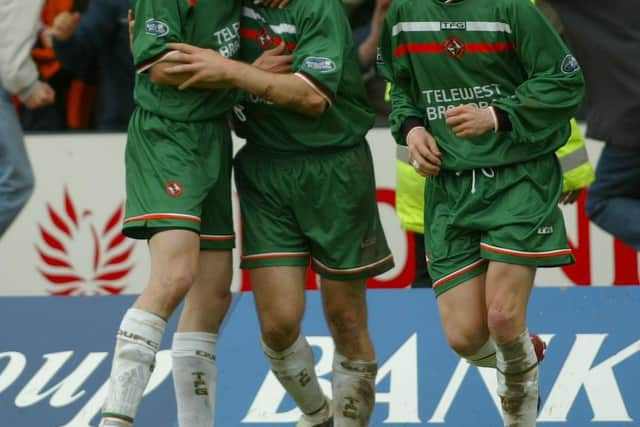Harps and Hibernians: How Hibs helped pave the way for the formation of Dundee United


When Hibs was founded in 1875, the club sprang up from Irish emigrants in Edinburgh’s “Little Ireland” community in the Cowgate. On Tayside, something similar was happening.
By the early 1850s, nearly a fifth of Dundee’s population was Irish-born – more than Glasgow – and the first club inspired by the Edinburgh Hibernians was established in 1879.
Advertisement
Hide AdAdvertisement
Hide AdHibs influence in Dundee


Dundee Harp was formed by teams from the Catholic parishes of St Andrew’s and St Joseph’s and like the Edinburgh club, the team was formed in close connection with the Catholic Young Men’s Society based on Tay Street and wore green and white in their infancy before switching to all-green shirts.
Harp and Hibs enjoyed a good relationship, and the Leithers made at least one trip up to the City of Discovery in August 1885 for a game at Harp Athletic Grounds. Unfortunately for Harp, they were eventually suspended by the Scottish FA in April 1894 over a financial issue and disbanded.
Around this time there were several Irish teams cropping up around Scotland. Celtic, Emmet, Erin, Harp, Hibernians, and Shamrock were all used by teams to set themselves apart from their geographical rivals, with a nod to the old country.
In Dundee alone there were a number of teams named Dundee Hibernian, even prior to the establishment of the Dundee Hibernian that evolved into Dundee United. One of these teams was formed from the ashes of Dundee Harp in September 1894 and, confusingly, called themselves Dundee Hibernian before rebranding to Dundee Harp in 1895 and disbanding in 1897. A third Dundee Harp team was then formed, playing at junior level until 1923.
Advertisement
Hide AdAdvertisement
Hide Ad

These teams wore predominantly green kits and given the timings of formation, will almost certainly have taken influence from the Edinburgh team.
Despite the short-lived nature of many of these clubs the city still had a huge Irish population, so it was no surprise when another Irish team in the city was established towards the end of the 1910s.
Birth of Dundee United
The Scottish Referee newspaper of March 22 1909 revealed that rumours of a new Irish club in Dundee were accurate. A report stated: “…Dundee Hibernians are now a duly organised body.
"The promoters are all Dundee Irishmen, and as the city is said to include in its population no less than thirty thousand of the same persuasion, the new organisation will not want for support. Mr Pat Reilly, the well-known cycle manufacturer, has been appointed secretary. The new club is meant to take the place of the defunct Harp, which was, in its time, one of the most prominent clubs outside of Glasgow.”
Advertisement
Hide AdAdvertisement
Hide AdThe club continued to grow. By mid-May Dundee Hibernians had taken over Clepington Park with previous tenants Dundee Wanderers forced to disband and sell off the grand stand. Led by Reilly, who took on most jobs as manager/secretary, the new club began to get estimates for a new pavilion and other improvements to Clepington Park, which they renamed Tannadice Park.
By the start of August, season ticket sales were healthy and the Dundee Telegraph reported that the committee anticipated breaking the four-figure mark before their first competitive match.
When Wanderers had been forced out of Clepington Park they had taken everything with them, so Dundee Hibernian were left with little more than a football pitch, and a mammoth effort was undertaken to get the ground up to scratch for the visit of Hibs.
Hibs v Hibs
A friendly match was fixed for August 18 1909 to officially open Tannadice Park, with Hibs travelling to Dundee to take on their namesakes. While there is no confirmation in news reports of the time, playing an exhibition match against Hibs was almost certainly a calculated decision to appeal to the target market.
Advertisement
Hide AdAdvertisement
Hide AdA reported crowd of between 6,000 and 7,000 was in attendance to watch the game, which finished 1-1 after Jamie Docherty cancelled out John O’Hara’s opener for Hibs, with both goals coming in the second half.
Half-back O’Hara only scored four goals in more than 100 appearances for Hibs, and was gifted a bicycle from Reilly as the first player to find the net at Tannadice Park.
Hibs togged out for this game wearing kits borrowed from Leith Amateurs to avoid a colour clash and in doing so, played in hooped shirts, albeit black and white rather than green and white, for the first time since 1879.
League acceptance, financial worries, and two name changes
Disappointed that the club had seen an application to join the Scottish League rejected in May 1909, Reilly spent a great deal of time lobbying Scottish League clubs and was rewarded for his efforts when Dundee Hibs were admitted to Division Two ahead of the 1910/11 season.
Advertisement
Hide AdAdvertisement
Hide AdLike many of their contemporaries, Dundee Hibs were rocked by financial issues that threatened their existence. Although they transferred to the Eastern League in 1915 their SFL membership was reinstated in 1919 and 1920 but on both occasions the club resigned without playing a game.
A group of local businessmen stepped in to save the club in the autumn of 1923. Dundee Hibs were reconstituted as Dundee City and given new colours of white and black in a bid to widen the club’s appeal.
However, rivals Dundee objected to the name and Dundee United was eventually chosen and ratified in October 1923, with the newly-named team playing their first game on October 27 against Dumbarton.
The future
United kept the white and black colours until as late as 1969, when they switched to tangerine shirts and black shorts. They had worn this combination while competing as Dallas Tornado in the United Soccer Association in 1967 and it was the wife of manager Jerry Kerr who persuaded the Tannadice outfit to adopt the colours.
Advertisement
Hide AdAdvertisement
Hide AdA green change kit was worn in the early 2000s in a nod to the club’s formative years as Dundee Hibernians.
A message from the Editor:
Thank you for reading this article. We're more reliant on your support than ever as the shift in consumer habits brought about by Coronavirus impacts our advertisers.
If you haven't already, please consider supporting our sports coverage with a digital sports subscription.
Comment Guidelines
National World encourages reader discussion on our stories. User feedback, insights and back-and-forth exchanges add a rich layer of context to reporting. Please review our Community Guidelines before commenting.